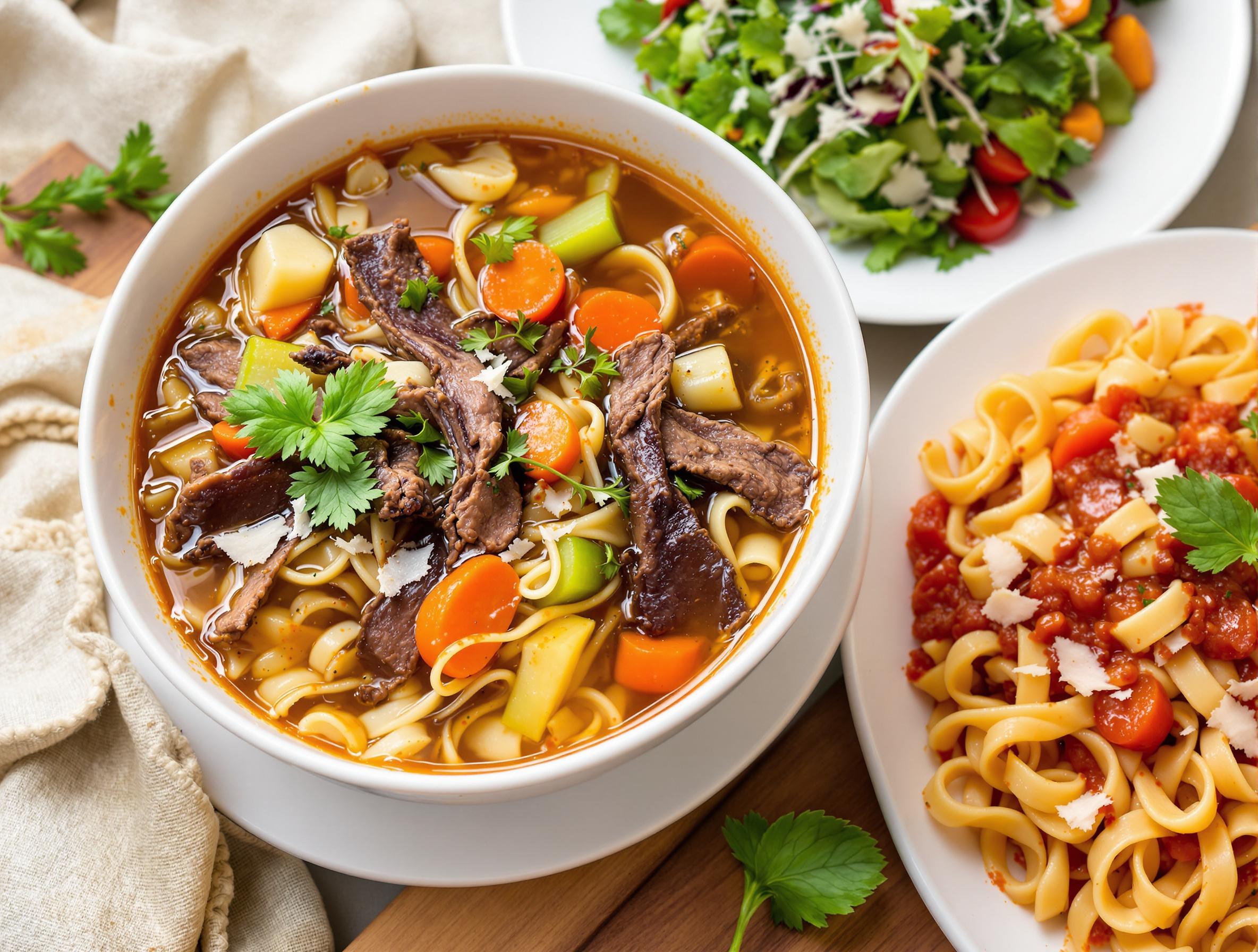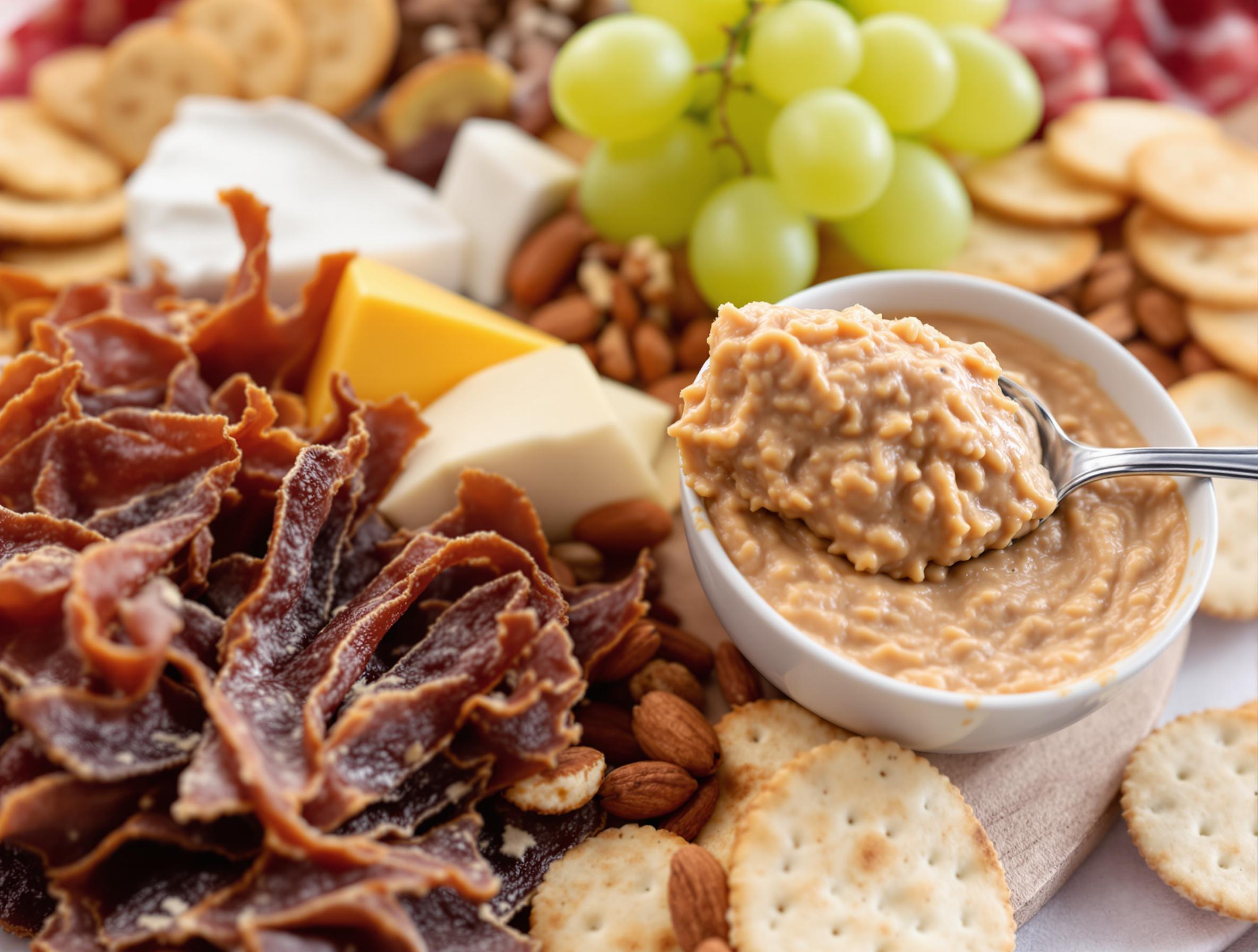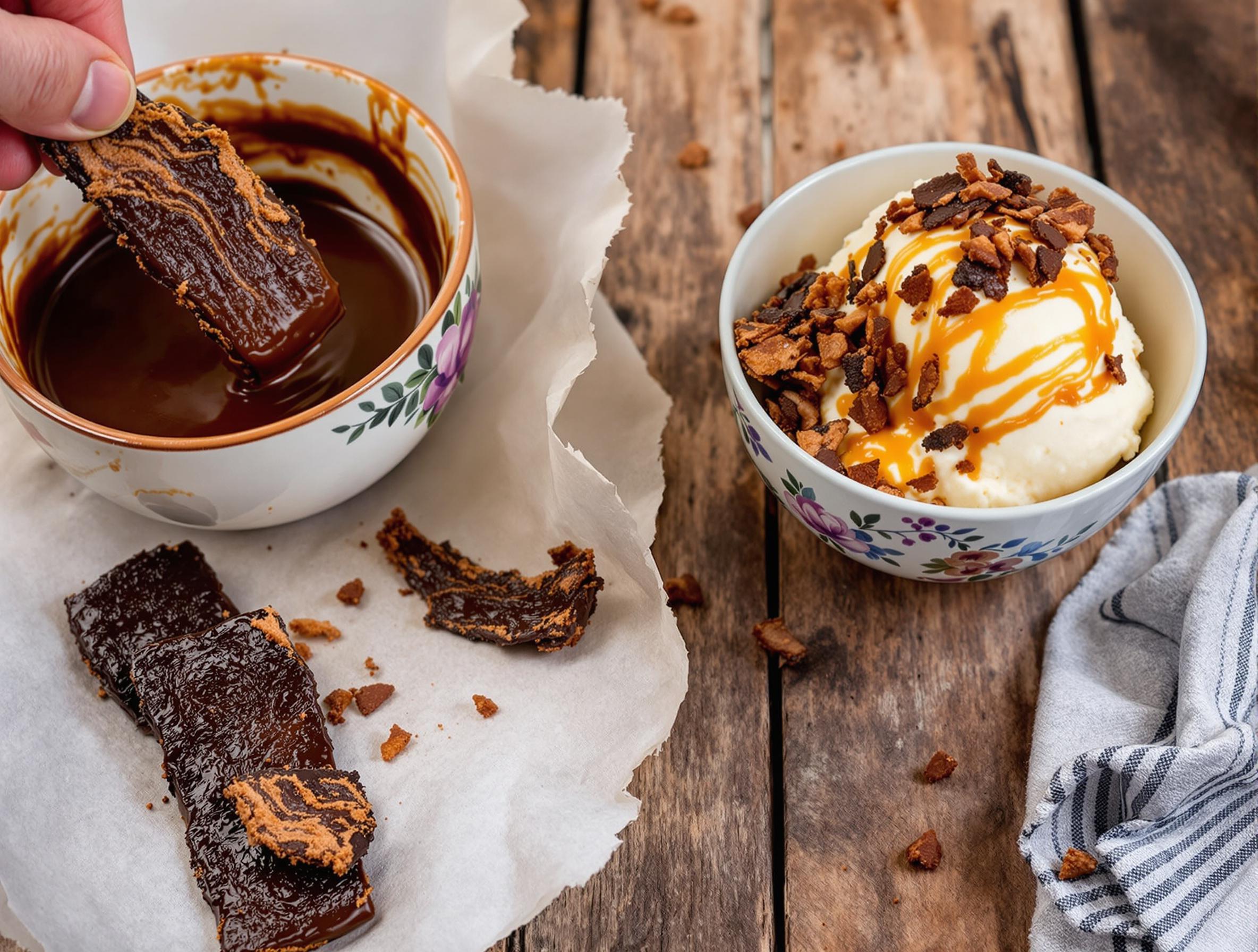Beef jerky is a beloved snack known for its rich flavor and protein-packed goodness. But did you know that this versatile treat can be used in a variety of creative ways beyond just snacking? From enhancing meals to adding a unique twist to your favorite dishes, beef jerky offers endless possibilities. Let’s explore some innovative uses for beef jerky that will elevate your culinary adventures.
Creative Uses for Beef Jerky
Beef Jerky as a Cooking Ingredient

-
Soups and Stews: Adding beef jerky to soups and stews can infuse them with a rich, smoky flavor. The jerky softens as it cooks, adding depth and texture to your dish. This works particularly well in hearty winter soups or slow-cooked stews where the flavors have time to meld together. You can experiment with different types of beef jerky, such as teriyaki or black pepper, to add unique flavors to your soups. For more inspiration, check out our beef jerky soup recipe and learn how to rehydrate beef jerky in soup.
-
Salads: Use beef jerky as a protein topping for salads. It adds a savory crunch that complements fresh greens and vegetables. Consider pairing beef jerky with robust salad ingredients like kale, spinach, or arugula. You can also mix it with fruits like apples or pears for a sweet and savory combination. The jerky can be tossed in a vinaigrette or used as a garnish for added texture.
-
Pasta Dishes: Incorporate beef jerky into pasta sauces or as a topping for an extra layer of flavor. It pairs well with tomato-based sauces and creamy Alfredo. For a unique twist, try adding beef jerky to a carbonara sauce, where the smoky flavor complements the richness of the eggs and cheese. You can also use it in stuffed pasta dishes, like ravioli or tortellini, for a surprising burst of flavor.
Beef Jerky in Appetizers and Snacks

-
Charcuterie Boards: Elevate your charcuterie boards by including beef jerky alongside cheeses, fruits, and nuts. It adds a hearty, meaty element that complements other flavors. Consider pairing it with sharp cheddar, blue cheese, or smoked gouda for a bold flavor profile. You can also include pickled vegetables or olives to balance the richness of the jerky.
-
Dips and Spreads: Blend beef jerky into dips and spreads for a unique twist. Try mixing it with cream cheese or hummus for a protein-packed snack. For a smoky flavor, blend beef jerky with sour cream and chives to create a dip for chips or vegetables. You can also incorporate it into a cheese ball recipe, rolling the ball in crushed beef jerky for added texture and flavor.
-
Stuffed Bread: Create beef jerky-stuffed bread or rolls for a satisfying appetizer. The jerky adds a savory flavor that pairs well with melted cheese. Consider using a variety of cheeses, such as mozzarella, cheddar, or provolone, to complement the jerky’s flavor. You can also add other ingredients like caramelized onions, roasted peppers, or fresh herbs for added depth.
Beef Jerky in Main Dishes

-
Pizza Toppings: Use beef jerky as a unique pizza topping. Its chewy texture and smoky flavor add a delightful contrast to traditional toppings. Consider pairing it with complementary ingredients like mushrooms, onions, or bell peppers. You can also experiment with different types of cheese, such as goat cheese or feta, to create a unique flavor profile.
-
Casseroles: Add beef jerky to casseroles for extra flavor and texture. It’s a great way to incorporate protein into comforting dishes. Consider using it in classic casseroles like green bean casserole or hash brown casserole. You can also create new casserole recipes, such as a beef jerky and macaroni casserole, for a hearty and satisfying meal.
-
Stir-Fries: Incorporate beef jerky into stir-fries for a burst of flavor. Its chewy texture complements the crispness of vegetables. Consider using it in a variety of stir-fry recipes, such as a beef jerky and vegetable stir-fry with a soy-ginger sauce or a spicy stir-fry with chili peppers and garlic. You can also experiment with different types of vegetables, such as broccoli, snap peas, or carrots, to create a colorful and flavorful dish.
Beef Jerky in Desserts

-
Sweet and Savory Treats: Create desserts that combine sweet and savory flavors with beef jerky. Think chocolate-dipped jerky or jerky-infused caramel. For a unique twist, try making beef jerky brittle by combining it with melted sugar and nuts. You can also incorporate it into baked goods, such as cookies or brownies, for a surprising crunch.
-
Ice Cream Toppings: Use beef jerky as an unexpected ice cream topping. The contrast between sweet and savory will delight your taste buds. Consider pairing it with flavors like vanilla, salted caramel, or chocolate. You can also create a sundae bar with a variety of toppings, including beef jerky, for a fun and interactive dessert experience.
Beef Jerky in Beverages
-
Cocktails: Infuse cocktails with beef jerky flavors for a unique twist. Try a jerky-infused Bloody Mary or a smoky whiskey cocktail. For a creative garnish, use a slice of beef jerky instead of traditional celery or olives. You can also experiment with different types of spirits, such as bourbon or tequila, to create a signature cocktail.
-
Bloody Marys: Use beef jerky as a garnish for Bloody Marys. It adds a savory element that complements the tomato juice and spices. Consider pairing it with other garnishes, such as pickled vegetables, shrimp, or cheese cubes, for a hearty and satisfying drink. You can also experiment with different types of beef jerky, such as spicy or teriyaki, to add unique flavors to your Bloody Mary.
Making and Storing Beef Jerky

Best Cuts of Meat for Beef Jerky
-
Top Round: Lean and economical, great for large-scale production. It’s a popular choice for its consistency and flavor. Top round is often used in commercial jerky production due to its large size and ease of slicing. It’s a versatile cut that can be used in a variety of jerky recipes, from classic to exotic flavors.
-
Bottom Round: Lean and affordable, slightly tougher than top round. It’s a versatile cut that works well for jerky. Bottom round is a great option for those looking to make jerky on a budget. Its slightly tougher texture makes it ideal for jerky, as the drying process helps to tenderize the meat.
-
Flank Steak: Packed with flavor, requires slicing against the grain. Its long, tough grains make it ideal for jerky. Flank steak is a popular choice for homemade jerky due to its rich flavor and tender texture. It’s important to slice flank steak against the grain to ensure tenderness, as the muscle fibers can be tough.
-
Sirloin Tip: Lean and tender, slightly more expensive. It offers a subtle beef flavor that’s perfect for jerky. Sirloin tip is a great option for those looking to make high-quality jerky with a tender texture. Its subtle flavor makes it a versatile choice for a variety of jerky recipes.
-
Lifter and Pectoral: Rich flavor, tender texture, may have more fat. These cuts provide excellent beef flavor and a nice chew. Lifter and pectoral are lesser-known cuts that are perfect for jerky due to their rich flavor and tender texture. They may have more fat than other cuts, but this can add to the flavor and texture of the jerky.
-
Brisket: Rich and flavorful, can be challenging to find lean cuts. It’s a delicious choice for jerky when trimmed properly. Brisket is a popular cut for smoking and barbecuing, but it can also be used to make delicious jerky. It’s important to trim the fat from brisket before making jerky, as excess fat can lead to spoilage.
-
Skirt Steak: Flavorful but may have higher fat content. It’s a lean cut that’s perfect for jerky when trimmed. Skirt steak is a thin and flavorful cut that is ideal for jerky. Its higher fat content can add to the flavor and texture of the jerky, but it’s important to trim excess fat before drying.
Tips for Making Beef Jerky at Home
-
Marinades: Experiment with different marinades for unique flavors. Try combinations of soy sauce, Worcestershire, and spices. Marinades can add depth and complexity to the flavor of your jerky. Consider using a variety of ingredients, such as honey, garlic, or chili peppers, to create unique flavor profiles. You can also experiment with different types of liquids, such as beer or wine, to add depth to your marinade.
-
Dehydration Techniques: Use a dehydrator or oven for drying beef jerky. Ensure it’s fully dehydrated for shelf stability. Dehydrating beef jerky is a crucial step in the process, as it helps to preserve the meat and prevent spoilage. It’s important to ensure that the jerky is fully dehydrated, as any remaining moisture can lead to mold or bacterial growth. You can use a dehydrator or oven to dry your jerky, depending on your preference and available equipment.
-
Storage Tips: Store beef jerky in an airtight container at room temperature. Properly stored, it can last for several weeks to a few months. Storing beef jerky properly is essential for maintaining its freshness and flavor. It’s important to keep it in an airtight container to prevent exposure to air and moisture, which can lead to spoilage. You can also store beef jerky in the refrigerator or freezer for extended shelf life.
Health Benefits of Beef Jerky
-
Protein Source: High in protein, essential for muscle repair and growth. It’s a convenient way to boost your protein intake. Beef jerky is an excellent source of protein, which is essential for muscle repair and growth. It’s a convenient and portable snack that can help you meet your daily protein needs, especially if you’re following a high-protein diet or engaging in physical activity.
-
Nutrient-Dense: Contains vitamins and minerals like zinc and iron. These nutrients support immune function and energy levels. Beef jerky is a nutrient-dense snack that contains essential vitamins and minerals. Zinc and iron are important for immune function, energy levels, and overall health. Including beef jerky in your diet can help you meet your daily nutrient needs, especially if you’re following a restricted diet or have specific nutritional goals.
-
Portable Snack: Easy to carry, perfect for travel and outdoor activities. It’s a convenient snack that fits any lifestyle. Beef jerky is a portable and convenient snack that is perfect for travel, outdoor activities, or on-the-go meals. Its shelf-stable nature makes it an ideal choice for those who need a quick and easy protein source, such as hikers, campers, or busy professionals.
FAQs
-
What is beef jerky?
- Beef jerky is a nutrient-dense meat snack that has been cooked and dehydrated to become shelf-stable. It’s made from thin strips of beef that are marinated, dried, and preserved with salt and other seasonings. Beef jerky has a long history dating back to ancient civilizations, who used drying techniques to preserve meat for extended periods.
-
Is beef jerky healthy?
- Beef jerky is generally healthy, high in protein, and contains essential vitamins and minerals. However, it’s important to choose jerky that is low in sodium and added sugars, as some commercial varieties can be high in these ingredients. Making beef jerky at home allows you to control the ingredients and customize the flavor to your liking.
-
How long does beef jerky last?
- Properly stored beef jerky can last for several weeks to a few months. The shelf life of beef jerky depends on factors such as the moisture content, storage conditions, and the presence of preservatives. To extend the shelf life of beef jerky, store it in an airtight container in a cool, dry place away from direct sunlight.
-
Can you make beef jerky at home?
- Yes, making beef jerky at home allows for customization of flavors and control over ingredients. Homemade beef jerky can be tailored to your specific dietary needs and preferences, such as low-sodium or gluten-free. You can use a dehydrator or oven to dry the jerky, depending on your available equipment and desired texture.
-
What are the best cuts of meat for beef jerky?
- The best cuts include top round, bottom round, flank steak, and sirloin tip. These cuts are lean, flavorful, and ideal for making jerky due to their low fat content and tender texture. Other cuts, such as brisket or skirt steak, can also be used to make jerky, but may require additional trimming to remove excess fat.
Conclusion
Beef jerky is more than just a snack; it’s a versatile ingredient that can enhance a variety of dishes. From appetizers to main courses and even desserts, the possibilities are endless. Experiment with these creative uses and discover new ways to enjoy this protein-packed treat.
For more inspiration, check out these delicious beef jerky marinade recipes and learn about the health benefits of beef jerky. Happy cooking!